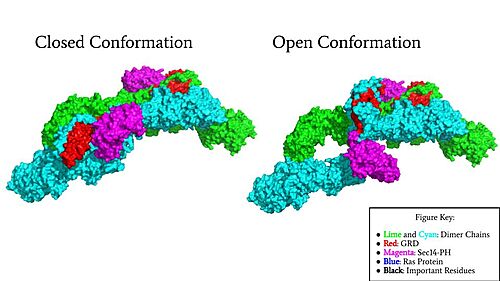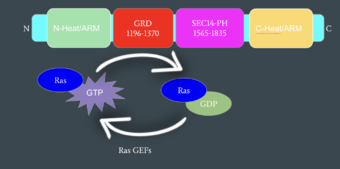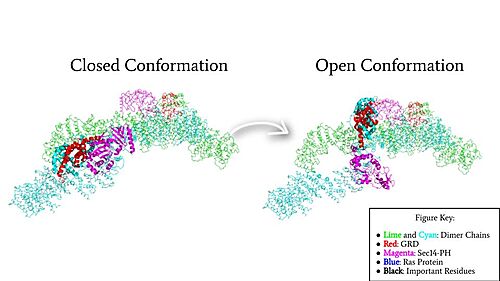Sandbox Reserved 1710
From Proteopedia
(Difference between revisions)
| Line 15: | Line 15: | ||
== Structure == | == Structure == | ||
[[Image:Neurofibromin_Cartoon_Domains.jpg|500 px|right|thumb|Figure 3: Neurofibromin Important Domains in one chain of the homodimer]] | [[Image:Neurofibromin_Cartoon_Domains.jpg|500 px|right|thumb|Figure 3: Neurofibromin Important Domains in one chain of the homodimer]] | ||
| - | Neurofibromin is a <scene name='90/904315/Homodimer/5'>homodimer</scene> made up of two identical chains. Neurofibromin has two conformations, open and closed. Shifting between these controls neurofibromin's ability to associate with Ras and perform its function of Ras regulation. The transformation between the overall closed and open conformations transitions it from an active to inactive state. There are <scene name='90/904315/Sec14ph_and_grd_domain/1'>two important domains</scene> involved in the transition between the open and closed conformations, the <scene name='90/904316/Grd_domains/2'>GRD</scene> domain and the <scene name='90/904315/Sec14ph_domain/3'>Sec14-PH</scene> domain. The GRD and the Sec14-PH domain are centrally linked by an asymmetric, homodimeric core of four [https://en.wikipedia.org/wiki/Armadillo_repeat ARM] repeats and 27 [https://en.wikipedia.org/wiki/HEAT_repeat HEAT] repeats. The GRD and Sec14-PH domains extend out from the <scene name='90/904315/N-heat_arm/1'>N-HEAT/ARM</scene> core and then return to the <scene name='90/904315/C-heat_arm/1'>C-HEAT/ARM</scene> core. The orientation of the GRD and Sec-14 in relation to the N-HEAT/ARM and C-Heat/ARM determine what conformation neurofibromin is in. Although neurofibromin is a homodimer with two identical protomers, only one protomer has its GRD and Sec14-PH domains rotated into the <scene name='90/904315/Open_conformation/4'>open conformation</scene>.<ref name="Naschberger">PMID:34707296</ref> | + | Neurofibromin is a <scene name='90/904315/Homodimer/5'>homodimer</scene> made up of two identical chains. Neurofibromin has two conformations, open and closed. Shifting between these controls neurofibromin's ability to associate with Ras and perform its function of Ras regulation. The transformation between the overall closed and open conformations transitions it from an active to inactive state. There are <scene name='90/904315/Sec14ph_and_grd_domain/1'>two important domains</scene> involved in the transition between the open and closed conformations, the <scene name='90/904316/Grd_domains/2'>GRD</scene> domain and the <scene name='90/904315/Sec14ph_domain/3'>Sec14-PH</scene> domain. The GRD and the Sec14-PH domain are centrally linked by an asymmetric, homodimeric core of four [https://en.wikipedia.org/wiki/Armadillo_repeat ARM] repeats and 27 [https://en.wikipedia.org/wiki/HEAT_repeat HEAT] repeats (Figure 3). The GRD and Sec14-PH domains extend out from the <scene name='90/904315/N-heat_arm/1'>N-HEAT/ARM</scene> core and then return to the <scene name='90/904315/C-heat_arm/1'>C-HEAT/ARM</scene> core. The orientation of the GRD and Sec-14 in relation to the N-HEAT/ARM and C-Heat/ARM determine what conformation neurofibromin is in. Although neurofibromin is a homodimer with two identical protomers, only one protomer has its GRD and Sec14-PH domains rotated into the <scene name='90/904315/Open_conformation/4'>open conformation</scene>.<ref name="Naschberger">PMID:34707296</ref> |
== Conformational States == | == Conformational States == | ||
Revision as of 20:14, 18 April 2022
| This Sandbox is Reserved from February 28 through September 1, 2022 for use in the course CH462 Biochemistry II taught by R. Jeremy Johnson at the Butler University, Indianapolis, USA. This reservation includes Sandbox Reserved 1700 through Sandbox Reserved 1729. |
To get started:
More help: Help:Editing |
Human Neurofibromin - The Tumor Suppressor Gene
| |||||||||||
References
- ↑ 1.0 1.1 1.2 Trovo-Marqui AB, Tajara EH. Neurofibromin: a general outlook. Clin Genet. 2006 Jul;70(1):1-13. doi: 10.1111/j.1399-0004.2006.00639.x. PMID:16813595 doi:http://dx.doi.org/10.1111/j.1399-0004.2006.00639.x
- ↑ 2.0 2.1 2.2 2.3 2.4 2.5 2.6 Naschberger A, Baradaran R, Rupp B, Carroni M. The structure of neurofibromin isoform 2 reveals different functional states. Nature. 2021 Nov;599(7884):315-319. doi: 10.1038/s41586-021-04024-x. Epub 2021, Oct 27. PMID:34707296 doi:http://dx.doi.org/10.1038/s41586-021-04024-x
- ↑ 3.0 3.1 Lupton CJ, Bayly-Jones C, D'Andrea L, Huang C, Schittenhelm RB, Venugopal H, Whisstock JC, Halls ML, Ellisdon AM. The cryo-EM structure of the human neurofibromin dimer reveals the molecular basis for neurofibromatosis type 1. Nat Struct Mol Biol. 2021 Dec;28(12):982-988. doi: 10.1038/s41594-021-00687-2., Epub 2021 Dec 9. PMID:34887559 doi:http://dx.doi.org/10.1038/s41594-021-00687-2
- ↑ 4.0 4.1 4.2 Ratner N, Miller SJ. A RASopathy gene commonly mutated in cancer: the neurofibromatosis type 1 tumour suppressor. Nat Rev Cancer. 2015 May;15(5):290-301. doi: 10.1038/nrc3911. Epub 2015 Apr 16. PMID:25877329 doi:http://dx.doi.org/10.1038/nrc3911
- ↑ 5.0 5.1 5.2 Abramowicz A, Gos M. Neurofibromin in neurofibromatosis type 1 - mutations in NF1gene as a cause of disease. Dev Period Med. 2014 Jul-Sep;18(3):297-306. PMID:25182393
- ↑ Bergoug M, Doudeau M, Godin F, Mosrin C, Vallee B, Benedetti H. Neurofibromin Structure, Functions and Regulation. Cells. 2020 Oct 27;9(11). pii: cells9112365. doi: 10.3390/cells9112365. PMID:33121128 doi:http://dx.doi.org/10.3390/cells9112365




